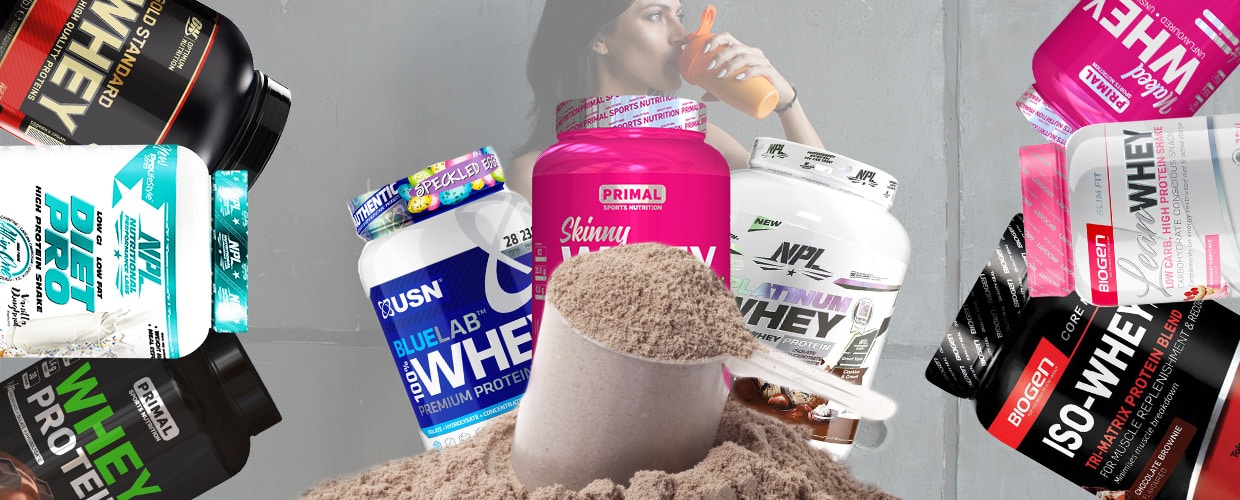Yummy whey… it’s everyone’s favourite supplement. There are so many amazing flavours to choose from and it’s such an effective and functional product, which makes it a ‘must-have’ in the supplement cupboards.
The main reason why whey is worth the investment is that it works! Whey has the highest biological value of any protein source, which means that it is rapidly absorbed and utilised by the body to repair and build muscle after training.
Whey is functional, effective and versatile
It’s a rich source of beneficial Branched Chain Amino Acids (BCAAs), which are involved in protein synthesis and help to build lean muscle when combined with regular training and a healthy balanced diet.
But whey does more than merely maximise muscle growth. Research shows that whey protein can greatly assist with toning, too. There are numerous reasons for this, not least of which is the fact that your increased muscle mass raises your basal metabolic rate, which ensures you burn more calories throughout the day, even while at rest.
Defining your whey protein options
But when you look beyond the flavour label and enticing branding on the tub, you’ll start to see words like concentrate, isolate and hydrolysate. You’ll also notice differences in protein content and price between both products and brands.
While price-conscious consumers often select their whey protein based on price, a bargain may not always deliver the benefits you’re after.
And given the amazing selection of products available at Dis-Chem (both online and in-store) and each product’s different attributes, trying to make the best choice can seem daunting.
To ensure you buy the best product to meet your needs and get the most from your purchase, here’s a comprehensive guide to finding the best product for you.
Defining the different types of whey
Standard whey protein supplements typically come in three forms;
- Concentrate
- Isolate
- Hydrolysate
All whey is a by-product of the cheese-making process, with the final powder you buy is derived from the liquid that remains.
This liquid typically undergoes additional processing and pasteurisation and is then filtered, using either ultra-filtration and/or cross-flow micro-filtration to remove excess lactose and fat. The resultant product is then spray dried to form regular whey protein concentrate. Additional processing can also be done to produce an isolate or hydrolysate.
What you’re left with is what’s generally considered the gold standard in protein due to whey’s complete amino acid profile, which includes all nine essential amino acids (EAAs) and BCAAs.
Whey concentrates:
- Generally, one of the most common forms of whey protein as it is the most cost-effective.
- It’s the least processed form of whey and, therefore, retains higher levels of bioactive compounds, but requires more time to digest and delivers a slower release of amino acids.
- Contains carbohydrates in the form of lactose, with low levels of fat and cholesterol.
- Are 29–89% protein by weight, depending on the manufacturer.
Whey isolates:
- Undergoes additional refining to remove excess fat and lactose.
- More bioavailable than concentrates, offering an intermediate amino acid release profile.
- Expect a marginal increase in price over concentrates.
- Usually lower in bioactive compounds. For example, some the sub-fractions, like alpha-lactoglobulins and lactoferrins, are removed in the filtering process.
- Offers at least 90%+ total protein by volume.
Whey hydrolysates:
- Enzymatically pre-digested, partially hydrolysed whey proteins where larger peptides and micro-fractions are broken down.
- Contains a very low-fat content.
- Most easily digested and absorbed form of whey, offering the highest bioavailability due to the additional processing.
- Generally costs more to manufacture and therefore attracts a higher retail price.
Whey blends:
- Typically contains a combination of two or more whey protein sources such as isolate, concentrate and/or hydrolysate.
- Offers a combination of fast, medium and slow-releasing protein sources.
A few final considerations before buying a tub of whey
Solubility (the ease with which the product mixes in water) is an important consideration, especially if you plan to use your preferred whey in a variety of recipes. Any good quality whey protein should mix and stir into water relatively easily.
And a final word of caution! If you’re lactose intolerant, it may be beneficial to try non-dairy or plant-based protein option.
Recommendation for storing whey products:
- Stored in cool, dry environments.
- Store products below 26°C with a relative humidity of less than 65%.
- Store in airtight bags or containers.















